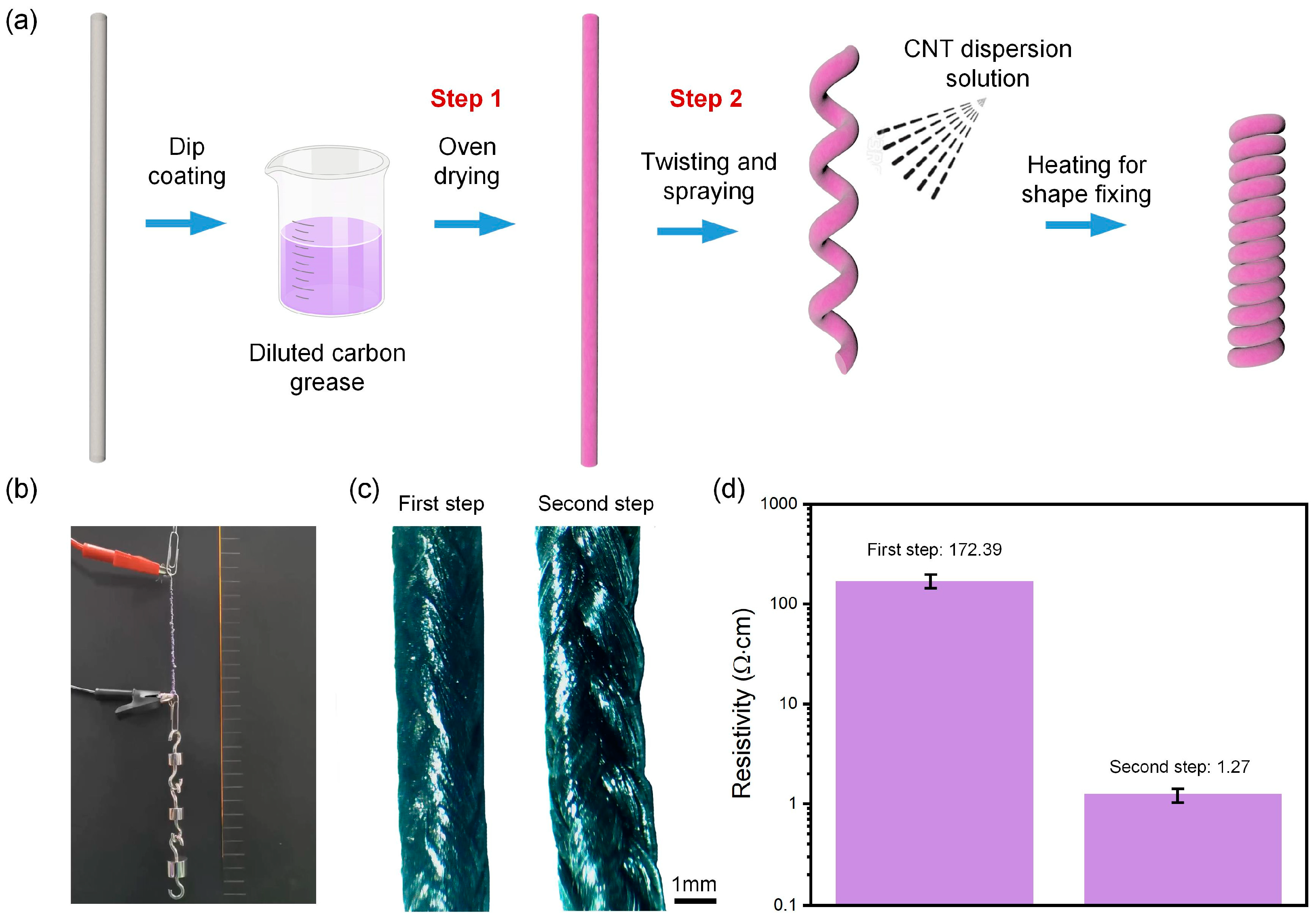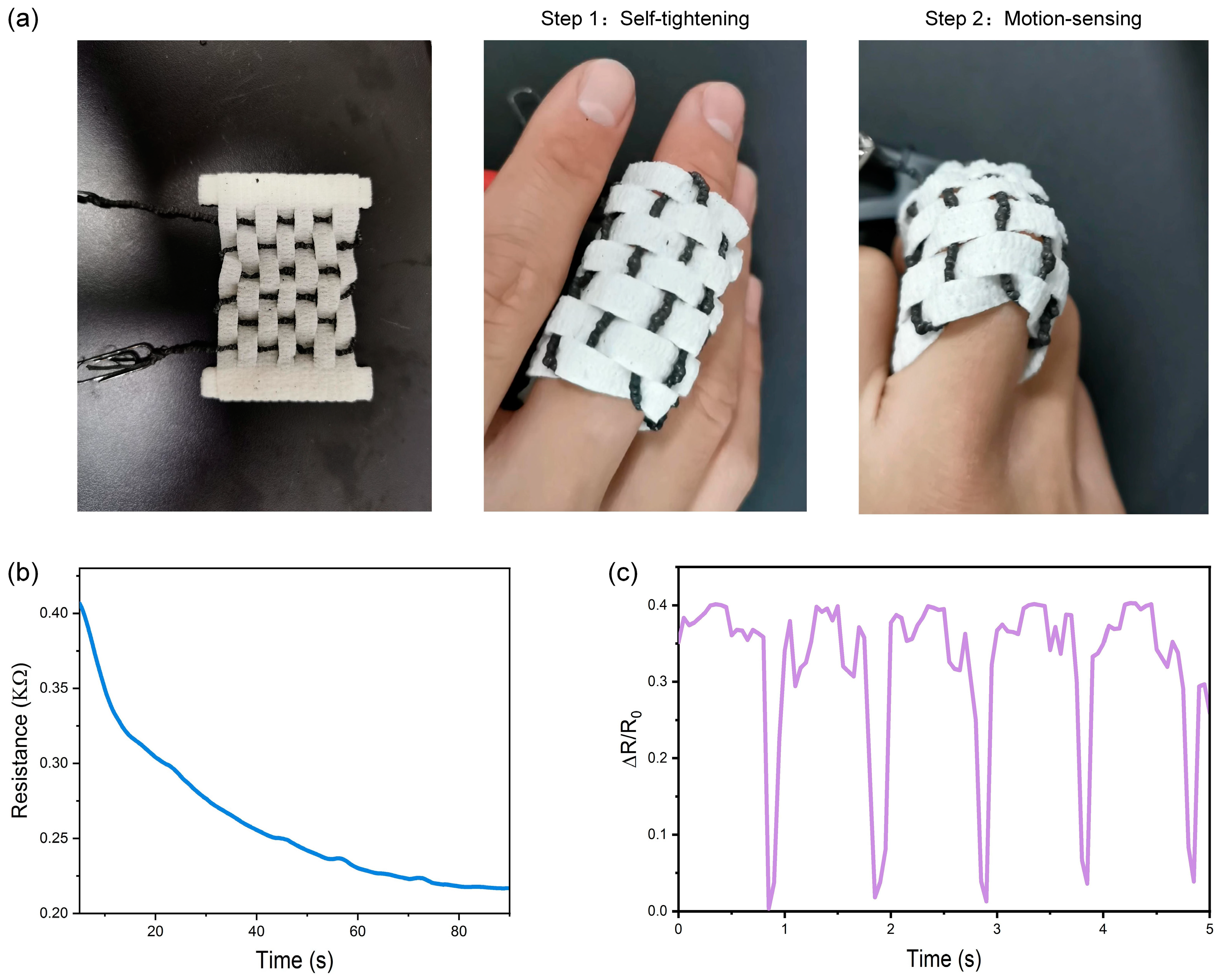Self-Aware Artificial Coiled Yarn Muscles with Enhanced Electrical Conductivity and Durability via a Two-Step Process
Abstract
1. Introduction
2. Materials and Methods
2.1. Fabrication of the Self-Aware Artificial Coiled Yarn Muscles
2.2. Characterization
2.3. Development of the Real-Time Signal Detection System in the Muscle Actuation Process
2.4. Statistical Analysis
3. Results and Discussion
3.1. Multimode Sense of Stretching Strain and Pressure
3.2. Actuation-Sensing Integration via Artificial Coiled Yarn Muscles
3.3. Proof-of-Concept Demonstrations
4. Conclusions
Author Contributions
Funding
Institutional Review Board Statement
Data Availability Statement
Conflicts of Interest
References
- Marko, J.F.; Siggia, E.D. Bending and Twisting Elasticity of DNA Volume 27, Number 4, February 14, 1994, pp 981–988. Macromolecules 1996, 29, 4820. [Google Scholar] [CrossRef]
- Gorin, A.A.; Zhurkin, V.B.; Olson, W.K. B-DNA Twisting Correlates with Base-Pair Morphology. J. Mol. Biol. 1995, 247, 34–48. [Google Scholar] [CrossRef]
- Studart, A.R.; Erb, R.M. Bioinspired Materials That Self-Shape through Programmed Microstructures. Soft Matter 2014, 10, 1284–1294. [Google Scholar] [CrossRef] [PubMed]
- Goriely, A.; Neukirch, S. Mechanics of Climbing and Attachment in Twining Plants. Phys. Rev. Lett. 2006, 97, 184302. [Google Scholar] [CrossRef]
- Schilthuizen, M.; Davison, A. The Convoluted Evolution of Snail Chirality. Naturwissenschaften 2005, 92, 504–515. [Google Scholar] [CrossRef] [PubMed]
- Frohlich, C.; Buskirk, R.E. Transmission and Attenuation of Vibration in Orb Spider Webs. J. Theor. Biol. 1982, 95, 13–36. [Google Scholar] [CrossRef]
- Haines, C.S.; Lima, M.D.; Li, N.; Spinks, G.M.; Foroughi, J.; Madden, J.D.W.; Kim, S.H.; Fang, S.; Jung de Andrade, M.; Goktepe, F.; et al. Artificial Muscles from Fishing Line and Sewing Thread. Science 2014, 343, 868–872. [Google Scholar] [CrossRef] [PubMed]
- Mu, J.; Jung de Andrade, M.; Fang, S.; Wang, X.; Gao, E.; Li, N.; Kim, S.H.; Wang, H.; Hou, C.; Zhang, Q.; et al. Sheath-Run Artificial Muscles. Science 2019, 365, 150–155. [Google Scholar] [CrossRef] [PubMed]
- Tawfick, S.; Tang, Y. Stronger Artificial Muscles, with a Twist. Science 2019, 365, 125–126. [Google Scholar] [CrossRef]
- Eggeler, G.; Hornbogen, E.; Yawny, A.; Heckmann, A.; Wagner, M. Structural and Functional Fatigue of NiTi Shape Memory Alloys. Mater. Sci. Eng. A 2004, 378, 24–33. [Google Scholar] [CrossRef]
- Zhou, X.; Fang, S.; Leng, X.; Liu, Z.; Baughman, R.H. The Power of Fiber Twist. Acc. Chem. Res. 2021, 54, 2624–2636. [Google Scholar] [CrossRef]
- Mirvakili, S.M.; Hunter, I.W. Artificial Muscles: Mechanisms, Applications, and Challenges. Adv. Mater. 2018, 30, 1704407. [Google Scholar] [CrossRef] [PubMed]
- Li, M.; Pal, A.; Aghakhani, A.; Pena-Francesch, A.; Sitti, M. Soft Actuators for Real-World Applications. Nat. Rev. Mater. 2022, 7, 235–249. [Google Scholar] [CrossRef]
- Wang, J.; Gao, D.; Lee, P.S. Recent Progress in Artificial Muscles for Interactive Soft Robotics. Adv. Mater. 2021, 33, 2003088. [Google Scholar] [CrossRef]
- Zou, M.; Li, S.; Hu, X.; Leng, X.; Wang, R.; Zhou, X.; Liu, Z. Progresses in Tensile, Torsional, and Multifunctional Soft Actuators. Adv. Funct. Mater. 2021, 31, 2007437. [Google Scholar] [CrossRef]
- Wang, Y.; Sun, J.; Liao, W.; Yang, Z. Liquid Crystal Elastomer Twist Fibers toward Rotating Microengines. Adv. Mater. 2022, 34, 2107840. [Google Scholar] [CrossRef]
- Ren, L.; Li, B.; Wei, G.; Wang, K.; Song, Z.; Wei, Y.; Ren, L.; Liu, Q. Biology and Bioinspiration of Soft Robotics: Actuation, Sensing, and System Integration. iScience 2021, 24, 103075. [Google Scholar] [CrossRef]
- Li, S.; Bai, H.; Liu, Z.; Zhang, X.; Huang, C.; Wiesner, L.W.; Silberstein, M.; Shepherd, R.F. Digital Light Processing of Liquid Crystal Elastomers for Self-Sensing Artificial Muscles. Sci. Adv. 2021, 7, eabg3677. [Google Scholar] [CrossRef] [PubMed]
- Leng, X.; Zhou, X.; Liu, J.; Xiao, Y.; Sun, J.; Li, Y.; Liu, Z. Tuning the Reversibility of Hair Artificial Muscles by Disulfide Cross-Linking for Sensors, Switches, and Soft Robotics. Mater. Horiz. 2021, 8, 1538–1546. [Google Scholar] [CrossRef] [PubMed]
- Truby, R.L.; Wehner, M.; Grosskopf, A.K.; Vogt, D.M.; Uzel, S.G.M.; Wood, R.J.; Lewis, J.A. Soft Robotics: Soft Somatosensitive Actuators via Embedded 3D Printing (Adv. Mater. 15/2018). Adv. Mater. 2018, 30, 1870106. [Google Scholar] [CrossRef]
- Zhao, H.; O’Brien, K.; Li, S.; Shepherd, R.F. Optoelectronically Innervated Soft Prosthetic Hand via Stretchable Optical Waveguides. Sci. Robot. 2016, 1, eaai7529. [Google Scholar] [CrossRef] [PubMed]
- Lo, C.Y.; Zhao, Y.; Kim, C.; Alsaid, Y.; Khodambashi, R.; Peet, M.; Fisher, R.; Marvi, H.; Berman, S.; Aukes, D.; et al. Highly Stretchable Self-Sensing Actuator Based on Conductive Photothermally-Responsive Hydrogel. Mater. Today 2021, 50, 35–43. [Google Scholar] [CrossRef]
- Chen, D.; Liu, Q.; Han, Z.; Zhang, J.; Song, H.; Wang, K.; Song, Z.; Wen, S.; Zhou, Y.; Yan, C.; et al. 4D Printing Strain Self-Sensing and Temperature Self-Sensing Integrated Sensor–Actuator with Bioinspired Gradient Gaps. Adv. Sci. 2020, 7, 2000584. [Google Scholar] [CrossRef] [PubMed]
- Amjadi, M.; Sitti, M. Self-Sensing Paper Actuators Based on Graphite-Carbon Nanotube Hybrid Films. Adv. Sci. 2018, 5, 1800239. [Google Scholar] [CrossRef] [PubMed]
- Yu, Y.; Li, L.; Liu, E.; Han, X.; Wang, J.; Xie, Y.X.; Lu, C. Light-Driven Core-Shell Fiber Actuator Based on Carbon Nanotubes/Liquid Crystal Elastomer for Artificial Muscle and Phototropic Locomotion. Carbon 2022, 187, 97–107. [Google Scholar] [CrossRef]
- Dong, L.; Ren, M.; Wang, Y.; Wang, G.; Zhang, S.; Wei, X.; He, J.; Cui, B.; Zhao, Y.; Xu, P. Artificial Neuromuscular Fibers by Multilayered Coaxial Integration with Dynamic Adaption. Sci. Adv. 2022, 8, eabq7703. [Google Scholar] [CrossRef]
- Dong, L.; Ren, M.; Wang, Y.; Qiao, J.; Wu, Y.; He, J.; Wei, X.; Di, J.; Li, Q. Self-Sensing Coaxial Muscle Fibers with Bi-Lengthwise Actuation. Mater. Horiz. 2021, 8, 2541–2552. [Google Scholar] [CrossRef]
- Dong, W.; Li, W.; Wang, K.; Luo, Z.; Sheng, D. Self-Sensing Capabilities of Cement-Based Sensor with Layer-Distributed Conductive Rubber Fibres. Sens. Actuators A Phys. 2020, 301, 111763. [Google Scholar] [CrossRef]
- Rossiter, J. Spinning Artificial Spiderwebs. Sci. Robot. 2020, 5, eabd0290. [Google Scholar] [CrossRef] [PubMed]
- Zhang, Y.L.; Li, J.C.; Zhou, H.; Liu, Y.Q.; Han, D.D.; Sun, H.B. Electro-Responsive Actuators Based on Graphene. Innovation 2021, 2, 100168. [Google Scholar] [CrossRef] [PubMed]
- Wang, R.; Shen, Y.; Qian, D.; Sun, J.; Zhou, X.; Wang, W.; Liu, Z. Tensile and Torsional Elastomer Fiber Artificial Muscle by Entropic Elasticity with Thermo-Piezoresistive Sensing of Strain and Rotation by a Single Electric Signal. Mater. Horiz. 2020, 7, 3305–3315. [Google Scholar] [CrossRef]






Disclaimer/Publisher’s Note: The statements, opinions and data contained in all publications are solely those of the individual author(s) and contributor(s) and not of MDPI and/or the editor(s). MDPI and/or the editor(s) disclaim responsibility for any injury to people or property resulting from any ideas, methods, instructions or products referred to in the content. |
© 2023 by the authors. Licensee MDPI, Basel, Switzerland. This article is an open access article distributed under the terms and conditions of the Creative Commons Attribution (CC BY) license (https://creativecommons.org/licenses/by/4.0/).
Share and Cite
Gong, Y.; Chen, W.; Li, J.; Zhao, S.; Ren, L.; Wang, K.; Li, B. Self-Aware Artificial Coiled Yarn Muscles with Enhanced Electrical Conductivity and Durability via a Two-Step Process. Polymers 2023, 15, 552. https://doi.org/10.3390/polym15030552
Gong Y, Chen W, Li J, Zhao S, Ren L, Wang K, Li B. Self-Aware Artificial Coiled Yarn Muscles with Enhanced Electrical Conductivity and Durability via a Two-Step Process. Polymers. 2023; 15(3):552. https://doi.org/10.3390/polym15030552
Chicago/Turabian StyleGong, Yongqi, Wanyi Chen, Jianyang Li, Shun Zhao, Luquan Ren, Kunyang Wang, and Bingqian Li. 2023. "Self-Aware Artificial Coiled Yarn Muscles with Enhanced Electrical Conductivity and Durability via a Two-Step Process" Polymers 15, no. 3: 552. https://doi.org/10.3390/polym15030552
APA StyleGong, Y., Chen, W., Li, J., Zhao, S., Ren, L., Wang, K., & Li, B. (2023). Self-Aware Artificial Coiled Yarn Muscles with Enhanced Electrical Conductivity and Durability via a Two-Step Process. Polymers, 15(3), 552. https://doi.org/10.3390/polym15030552







